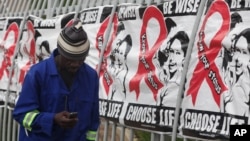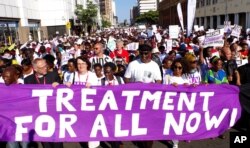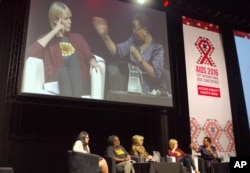Money is never far away from discussions around AIDS at settings like the International AIDS Conference, held this year in Durban, South Africa.
From international organizations to governments to social activists to pharmaceutical companies to individual patients, everyone agrees: AIDS is expensive, and more money is needed to fight it.
But the math behind the epidemic is often as complicated as the science.
Leena Menghaney, from aid group Doctors without Borders, tried to break down the main issues.
“One of the most important, significant things that we are very concerned about are the shortages of funding for the continued scale up of AIDS treatment,” she told VOA News. “For example, over the next few years people will need over $7 billion to be able to treat everybody who needs treatment. So there are these concerns about funding."
"But in contrast, not only is the money shrinking, what is problematic is the attack on Indian generics. India makes a lot of the medicines that are keeping people alive across the world, including people living with HIV," she added. "And the United States government is hellbent on changing the policies of the Indian government so that the next generation of medicines that we will need are shut down.”
But activists say there are unexpected financial needs beyond treatment and prevention.
For example, activists stormed the stage at the conference, drowning out South Africa’s health minister, to demand free condoms and sanitary pads in South African schools. The latter item might seem counterintuitive -- sanitary pads don’t prevent or treat HIV.
But in South Africa alone, studies have shown that 7 million girls miss school each month because they can’t afford hygiene items. That, says activist Ntombi-Zodwa Maphosa, has a bearing on the AIDS epidemic for those vulnerable girls.
“It definitely makes them vulnerable in society because then they can’t advance themselves and they fall prey to sexual predators, to older men, to transactional relationships, so it’s like a ripple effect,” she said. “It could seem really simple, but it has like long-term effects. So it’s also a tool for empowering young women to be educated and to advance in life.”
Alex Smith, director of Policy and Advocacy for AIDS Alabama, cited statistics that say that AIDS treatment over a lifetime could cost up to $1 million per patient.
But, he said, failing to treat people will cost society much more than that.
“There’s that old adage that an ounce of prevention is worth a pound of cure, and so I think that’s the same with treatment,” he said. “So if we are able to engage and maintain and retain people in treatment, then the overall cost to the healthcare system is decreased, because as people remain in care and are virally-suppressed, they will not transmit the virus to other people.”
And then there are the billions of billions of dollars behind pharmaceutical companies, which are often and repeatedly criticized by activists and aid groups for charging too much for drugs, for unnecessarily prolonging their patents and trying to prevent competition.
Drug companies say their costs are extremely high, that research doesn’t always yield results, and that they are ultimately responsible to shareholders to make a profit. The debate continues.
VOA tried to speak to at least six pharmaceutical companies at the conference, but none were available.
VOA also spoke to numerous HIV-positive conference attendees about what the virus costs them, and what they think would ease their burden. Again, the answers were varied and complicated - a Kazakh patient told us she is grateful she gets her medication free through government clinics, but said more services are needed, like integrated mental health and social welfare services.
Several African patients spoke of long queues for free medicine, and travel costs, childcare costs and the loss of income for waiting in line once a month at government clinics. Smith said he is grateful to his employer for providing private health insurance that covers his treatment - but mused that he might not be so lucky if he were to change jobs.
And every single patient pointed out the invisible cost of discrimination and stigma - that costs them professionally and personally.
It’s a complicated equation, and one that may defy an elegant solution.
But there is one number that no one can ignore, and which represents the virus’s ultimate cost: nearly 37 million lost lives.










